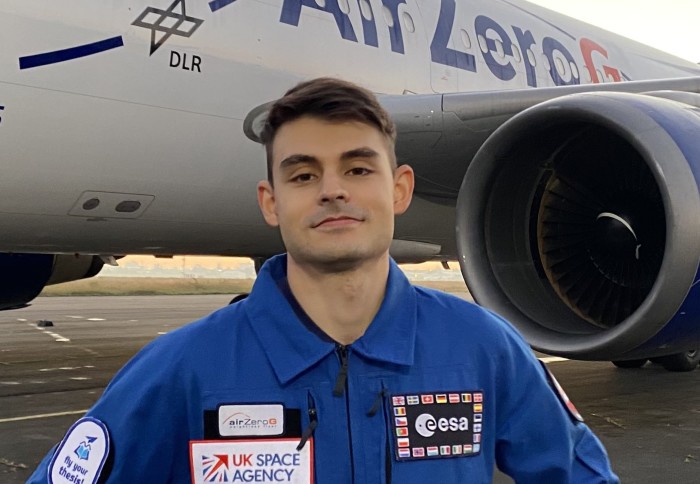Aeronautics PhD student takes parabolic flight to test new control technology
by Ayesha Khan

A team led by an Aeronautics PhD student has recently tested their newly developed spacecraft control method in microgravity conditions.
After successfully being selected for the European Space Agency’s (ESA) Fly Your Thesis programme, the DZH Dynamics team, headed by Jesús Manuel Muñoz Tejeda, PhD student in Space Technology, were invited to trial their control technology prototype on board an Air Zero-G/Novespace Airbus A310 aircraft, as part of the 77th ESA Parabolic Flight Campaign.
The international and multidisciplinary team achieved positive results as they effectively proved that the naturally occurring Dzhanibekov (DZH) phenomena can in fact be controlled by shifting object mass distribution in a calculated manner. The team refer to these new space vehicles as ‘transformable spacecraft’ as they can change their shape and mass distributions and hence control the DZH effect.
A transformable spacecraft prototype was specifically designed for the flight, completed with a release mechanism and rack to secure components inside the aircraft. From take-off, the team awaited periods of parabolic flight to trial their prototype. Precision and speed were key as microgravity conditions needed for each round only lasted 4-5 seconds.
As well as being given the incredible opportunity to validate the team’s research, Jesús also reflects on the testing conditions, “Experiencing microgravity is the most unique, priceless feeling I have ever experienced. The fact that humans have been able to construct a platform to achieve these conditions, when needed, is simply an engineering and scientific masterpiece.”
In the near future, transformable spacecraft could potentially revolutionise the way we see space vehicles nowadays. Jesús Manuel Muñoz Tejeda PhD Student, Department of Aeronautics
The technology, curated by the team, has not been developed previously and the experiment is the first of its kind - an important milestone towards testing in space.
Success of the prototype in space could lead to the potential for the technology to be used to steer spacecraft and satellites in orbit. Toggling the effect on and off will enable objects in space to turn faster using less energy consumption.
Dzhanibekov effect
The team, comprised of all levels of students from across Europe and young professionals, have been investigating attitude control methods since 2019 to understand how orientation of a complete space vehicle or satellite can be controlled.
The DZH effect naturally occurs when an object with a certain mass distribution is spun, around its intermediate axis of inertia, a a periodic 180-degree flip is generated. In shifting object mass distribution with the transformable spacecraft prototype, the team has proven that the DZH effect can be fully controlled and used for future space missions.
One use case of the technology would be to ensure spacecraft facing the sun are not overly exposed to heat. The control method would allow a periodic 180-degree attitude change when needed, meaning the side of the spacecraft facing the sun can then be shifted to face away from the sun, to allow for temperature control.
Find out more about the project on the DZH Dynamics website, LinkedIn, Instagram and YouTube.
Article text (excluding photos or graphics) © Imperial College London.
Photos and graphics subject to third party copyright used with permission or © Imperial College London.
Reporter
Ayesha Khan
Department of Aeronautics
